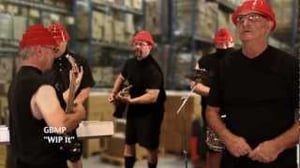Referred to either as “work in process” or “work in progress” (I think they’re the same thing), WIP is one of those manufacturing concepts that’s designed to confuse.
Firstly, it’s not really “work”, but the object of work. In fact, in a JIT world, when produced before it’s needed, even the work is not really work, but overproduction – considered the worst of the seven wastes. But traditional cost accounting wisdom turns a blind eye to that waste, and allows us to ‘store’ the labor and overhead consumed in the production (or over-production) until such time as we are able to build it into FG, “finished goods.” It’s hard to fathom this distinction as well, as finished goods are really just another stage of inventory produced before it is needed. In fact, it’s fairly commonplace even to pull material from a finished goods warehouse and rework it into something else, further blurring the distinction between FG and WIP. In any case, both are considered assets in conventional management accounting – like “money in the bank.” Very confusing.
But even more confusing is the second half of the phrase, “in process” (or progress.) In fact, for 99.9% of this class of material there is no progress – it’s just sitting somewhere awaiting further instructions. Take an order for a thousand pieces of widget X produced on a lathe. Only the part on the machine is really being processed, yet on the books we treat the entire batch as WIP. More than half of most production floors I visit are blanketed with this kind of WIP. (How’s yours?) Toyota uses the term “stagnation” to describe this condition, which more accurately depicts the myriad of inventory depots that clog production floors.
The WIP concept is more oblique when outside of production, where the queues may be expressed as piles of information in inboxes or patients staged in the hallway of a medical center, or groceries at a checkout counter. The negative impacts on productivity, quality and customer satisfaction are nevertheless the same. Stagnation of information and people, when they are the objects of work, is still stagnation.
WIP is all around us, hiding in plain sight and clogging the arteries of commerce. The GBMP team has produced a lighthearted video parody, "WIP It", to highlight a few examples, but there are many others. Where is your WIP? Let me hear from you.
O.L.D.
BTW: Feeling creative? We’re still soliciting Toast Kaizen parodies for the 2012 Northeast Shingo Conference.